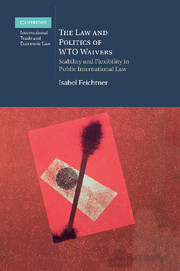Book contents
- Frontmatter
- Contents
- Acknowledgements
- 1 Why study the WTO waiver?
- Part I The stability/flexibility challenge in public international law and particularly the WTO
- Part II The practice and law of waivers
- Part III The potential of waivers to address the stability/flexibility challenge in international law
- 6 The potential of the waiver as a flexibility device
- 7 The politics of the waiver process
- 8 Conclusion
- Bibliography
- Index
8 - Conclusion
Published online by Cambridge University Press: 05 December 2011
- Frontmatter
- Contents
- Acknowledgements
- 1 Why study the WTO waiver?
- Part I The stability/flexibility challenge in public international law and particularly the WTO
- Part II The practice and law of waivers
- Part III The potential of waivers to address the stability/flexibility challenge in international law
- 6 The potential of the waiver as a flexibility device
- 7 The politics of the waiver process
- 8 Conclusion
- Bibliography
- Index
Summary
I set out in this study with large questions concerning the deficits in legitimacy and effectiveness of public international law and the WTO in particular. While sensitive to the deficits of WTO law when I began working on this topic, I am now convinced that it contributes to serious injustices. The redistributional consequences of the TRIPS Agreement to the detriment of the global poor and in favour of large pharmaceutical companies are but the most evident example.
Nonetheless, this study is based on the premise that international law and governance is needed more urgently than ever and that the WTO may play an important role in containing a bilateralism which might have even more detrimental consequences for the distribution of wealth in this world. It further rests on the argument that the legal form is indispensable to ensure that such governance may at least strive towards more representativeness and, consequently, global justice.
- Type
- Chapter
- Information
- The Law and Politics of WTO WaiversStability and Flexibility in Public International Law, pp. 353 - 354Publisher: Cambridge University PressPrint publication year: 2011

